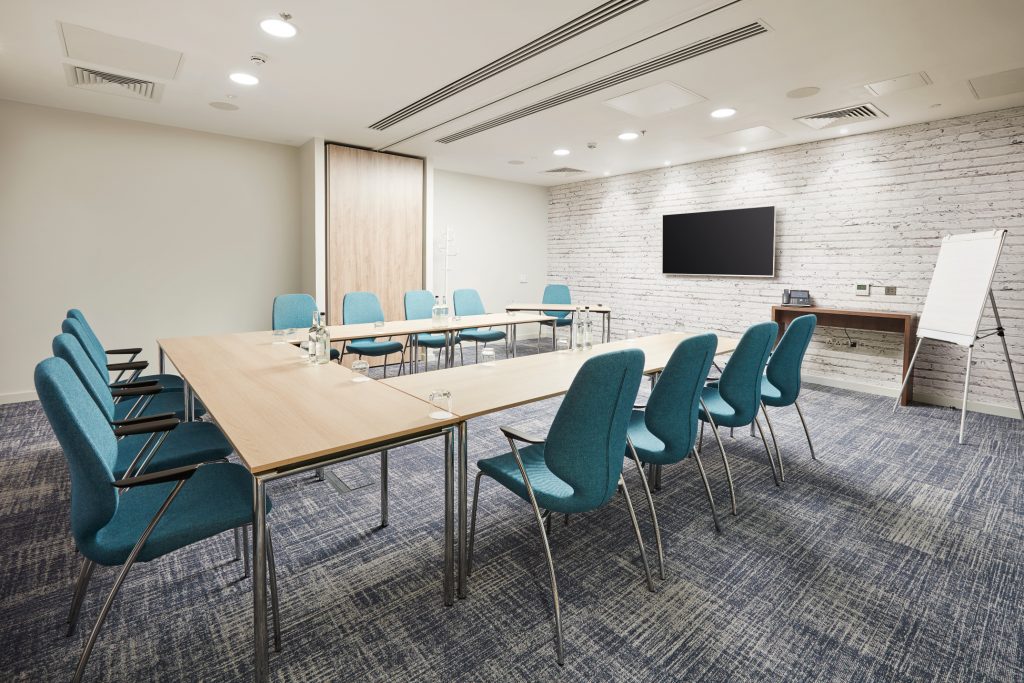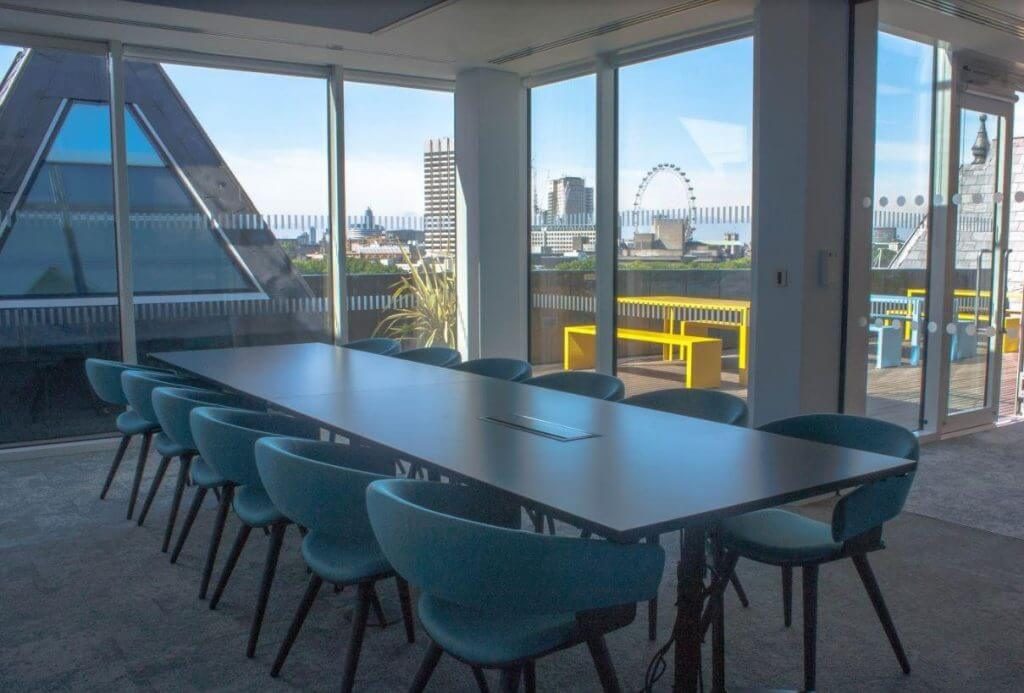Business meetings can serve all kinds of purposes, from the making of important decisions with the board of executives to catching up with your local sales team. They might seem boring and unnecessary at times, but a well-planned meeting can be very productive and boost the morale of all those involved. When a group or team is able to come together for a common purpose it can unleash an unlimited amount of potential.
If you’ve ever found yourself asking ‘how do you structure a team meeting?’ or ‘what exactly are the steps involved in organising successful meetings?’ then you’ve come to the right page, because we have the answers!
This checklist is divided into the four phases of meeting planning: 1. Purpose, 2. Timing, 3. Location, and 4. Participants. Each step on our checklist has further details below.
How to organise a successful meeting?
- How to organise a successful meeting?
- Purpose – Why a meeting?
- Step 1: Is a face to face meeting necessary?
- Step 2: What you want to accomplish?
- Step 3: Have an agenda
- Timing – When should we have the meeting?
- Location – Where should we have the meeting?
- Step 6: Choose a venue
- Step 7: What equipment and tools would you need?
- Step 8: Decide on seating and layout
- Participants – Who should be involved?
- Step 9: Who’s included?
- Step 10: Invite and inform the meeting participants
- Step 11: Who’s in charge?
- Step 12: Assign roles and delegate
- Step 13: Decide what the decision-making process will be
- Step 14: Send out a brief
- Step 15: Know your group
- After the meeting
- Tips and tools
Purpose – Why a meeting?
Step 1: Is a face to face meeting necessary?

First thing’s first, ask yourself “is a meeting really necessary?” Often you can get away with a smaller meetup, video conference or even an email memo instead of a large-scale or company-wide meeting. Meetings can be an incredibly useful way to maintain open communication with your colleagues; however, they do tend to absorb a considerable amount of time out of everyone’s schedule. It might be a good idea to skip the formal meeting if the reason for holding it can be handled in a quicker or less formal manner. Remember to be tactful when it comes to your coworkers and employees’ time. After all, time is money.
Step 2: What you want to accomplish?

What are the first steps to conducting a meeting? To start, It is important to know what you want to accomplish with this time. Have a purposeful vision and stick to it through the planning and execution of the meeting. Not all meetings are created equal, so early on, you’ll want to figure out what the purpose is for your meeting, and what type of format will best fit it. There are hundreds of reasons why you might gather the troops for a formal discussion, but here are ten of the most common reasons for a meeting:
- Progress update
- Review and assessment
- Planning
- Team building
- Problem Solving
- Training
- Innovation/brainstorm
- Information
- Decision making
- Problem-solving
Many of these reasons can be planned for in the same fashion, but each meeting is unique and should be planned to suit its specific purpose and needs. The type of meeting that you wish to have will dictate how you should plan for it; in the following steps, we will cover all the necessary steps toward planning any kind of meeting.
Step 3: Have an agenda

A meeting agenda is an organised list of what you plan to talk about, and in what order. This can be a list of decisions you need to make or general topics to discuss during the meeting. It may include your finish time and when you can take breaks. Sometimes this gets drawn up at the start of the meeting, but you can save time if it is prepared well in advance, in fact, we recommend that making an agenda be one of your first steps taken when planning a meeting.
Meetings can often get carried away in directions that you have not anticipated, so make an agenda that has all of the major points that you MUST get to, and sub-points that may be alright to skip if you end up being strapped for time at any point during the meeting. This is a great step to finish early on in your planning! Once you have an agenda, you can use it as a compass while going through the rest of the steps involved in organising your meeting.
Timing – When should we have the meeting?
Step 4: How much time do you need?

This can affect many other decisions that go into the planning of your meeting and should be decided early on. When determined, this should be factored into deciding the date, time, location, and the format of the meeting. If it is determined that you will require more than three hours for this meeting, consider breaking it into sessions that can take place over multiple sessions or days.
Step 5: Make sure key personnel will attend the meeting

Determine the key personnel that should be at the meeting and work with them to make sure that it fits into their schedules. You can’t plan a meeting around everyone’s schedule, but you should make sure that all of the essential people will be able to attend.
Location – Where should we have the meeting?
Step 6: Choose a venue

Where the meeting will be held can significantly change its feel and aesthetic. Be pointed and intentional when making these decisions. The first question you should ask yourself is “should this meeting be in-house, or at a third-party venue?” The benefits to an outside venue are numerous; they can typically aid in the preparation and organisation of the nitty-gritty details and can also provide a fresh environment for all in attendance. If you decide to go with an outside venue, check out our venue finder tool to find the perfect site for your meeting!
Step 7: What equipment and tools would you need?

Make plans for what type of equipment you need and make the necessary arrangements to have it all onsite when the room is readied for your meeting. Audio/visual equipment can seem simple enough, but there’s always something that can go wrong, from the projector not turning on to the microphone feeding back out of the speakers. All of the equipment should be checked before the meeting starts, especially the tech!
Also, think about the meeting management software and planning tools that you would need during your meeting. Video conferencing, meeting recordings, screen sharing, slideshare, file sharing and real time file collaboration, feedback and ratings, prioritization and progress tracking, tracking for follow-ups, action items and next steps, agenda creation are all features that could help you run productive and effective meetings. Read more about the top meeting management software of 2019 and about top tools for shared agendas, minutes, and scheduling.
Step 8: Decide on seating and layout

This can affect a meeting more than you might think. Arrange your setting and style to suit your group’s needs and preferences. By now, you have already discovered the purpose of the meeting, so now you can layout your seating and style of meeting accordingly. In addition to that, you should consider the people involved, if it’s assigned seating, be sensitive to those who may have specific needs or preferences. Make sure that any participant who will be speaking will be placed in a spot where they can be seen and heard. Many meetings will be perfectly served at a traditional conference room table, others will require a little bit more creativity.
Participants – Who should be involved?
Step 9: Who’s included?

You’ll need to begin a list of those to invite and include in the meeting. Depending on the size of the meeting, you may wish to divide this list by department, rank, and individual title.
Consider inviting a representative from every area of the company that the meeting’s decisions will affect so that their voice may be heard and they can express their point of view. Seemingly minor decisions can have a significant impact on the day-to-day life of your employees at every level. Be sure to consider their ideas and concerns before making changes that will directly impact their departments.
Step 10: Invite and inform the meeting participants

It’s time to send everyone on your list an official invite/inform of the meeting! Give each person details about the meeting as much in advance as possible. Be clear about what you hope to accomplish and what you wish for them to bring to the table. With the memo or invite that you send out, include any pre-meeting readings or reports that may be relevant for them to have prior to getting together. This will cut down on the number of emails you’ll have to send and will help people avoid missing out on important information.
Step 11: Who’s in charge?

Clear leadership is an essential part of any group meeting; the keeping of order is a vitally important task. Make sure to have a focused leader or leadership group in charge of the meeting; they will be responsible for keeping the whole team on track during the meeting and making sure that every key point is discussed. Be careful not to be overbearing when keeping order, allow a free-flow of discussion in between and around important topics while gently guiding the direction of the meeting as needed.
Step 12: Assign roles and delegate

The best meetings are ones where everyone knows why they are there, and there are no awkward silences. Have each person responsible for addressing the group be prepared for at least the introduction of their portion, and from there you can open up it for free conversation if fitting.
Take this opportunity to delegate some tasks to others whom you would like to give experience to; they will have a chance to grow, and you will get to see them develop in leadership. Delegation is important for two primary reasons: 1) it allows you to focus on other more critical tasks at hand, and 2) it will enable the delegate to grow in their management and organisation skills. Make yourself available to assist your co-planners when needed, but grant them enough freedom to implement their ideas and unique outlook as well.
In Amazon’s recent annual letter to shareholders, CEO Jeff Bezos discussed how Amazon executives read a lengthy memo at the start of each of their meetings. The memos don’t just outline the agenda, they actually include at least a basic summary of the issues at hand and some proposed solutions – everyone in the room must take the time to silently read the memo before the meeting can begin. Bezos explains that this procedure is often more about the memo writer than the reader – it requires them to put an extensive amount of thought and planning into the meeting preparations and allows their superiors to have a clear look at their work. To read more about this memo process, click here.
Step 13: Decide what the decision-making process will be

It’s a rarity for everyone to be 100% in agreement about decisions that must be made, and as such, it is imperative to have a transparent decision-making process. Here are six forms of decision making that you can use:
- Board decision
Whether it be a board of directors or a committee-board within the company, this is a popular decision-making option for a lot of hot-topic meetings. Board decisions offer a higher degree of checks and balances to assure that the company’s best interest will be considered. - Department heads
An easy to understand a shot-calling system that places each decision in the hands of the head of the department that it is most closely related to. - Majority vote
Not recommended for large-scale or company-wide meetings, but useful for smaller planning meetings and innovation meetings. Each attendee is given an equal say and vote in the decisions. - Leader’s decision
Simply put, the final say goes to the highest-ranking member of the meeting. After all, they’re the boss. - Best qualified
This form of decision making requires a solid understanding between members of the meeting but can be a powerful way to figure out difficult tasks at hand. Say you’re deciding what image to use on the homepage of your website – you could leave it up to the higher ranking member, or you could look to the best-qualified member such as a lower-ranking graphic designer who is clearly the best qualified to make that decision. - A combination of the above
As long as there is a good deal of cooperation within your group, you should be able to use some sort of combination of the above decision-making processes.
Step 14: Send out a brief

Although some meetings may not need this, in most cases it’s a great idea to send out a brief ahead of time to enable each attendee and observer to be fully aware of what is on the docket and what issues are at hand. This gives everyone enough advance time to reflect before being thrown into a sometimes stressful situation. You want everyone at their best for your meetings, so the more prepared you enable each participant to be, the better!
Step 15: Know your group

Some groups need extremely formal meetings, others respond better to a loose and relaxed approach. Know your audience and create your meeting to suit. It’s up to you to know if you HAVE to start on time or if it’s okay being a little late in lieu of a good conversation prior to your start.
Have you ever heard of a golf meeting? Sure it’s sometimes used as an excuse to go out and have fun, but oftentimes activity-centred meetings can be a good way to help people loosen up and speak their mind about all sorts of different subjects. Again, you have to know your group and plan a meeting that works best for those involved.
After the meeting
Step 16: Send out an overview of the meeting

Write up a general takeaway and overview of the meeting and send it out to each attendee at the end, and include anyone who missed the meeting. Send out specific briefs to all relevant departments. If applicable, include a to-do list and action memo specifying who is responsible for each item. A general follow-up will help everyone remain on the same page and maintain an open flow of information.
If an outside party was involved in the meeting, reach out to them and see what their thoughts were and ask if they have any questions about the meeting.
Tips and tools
- Be prepared
Make sure you are ready for your meeting with the appropriate materials and preparations. Research any topics that might be discussed that you may be less familiar with. The more prepared you are, the less likely that you will be caught off guard at any point during the meeting. - Be engaging
Don’t be dull when you interact during the meeting. After all, communication is the most important aspect of any meeting! Listen, summarise, validate, and speak clearly. - Be inclusive
Each person at the meeting is there for a reason, so make sure, when appropriate, to include everyone and encourage participation. - Hear your employees out
If someone has an idea, take the time to listen to what they have to say and consider their reasoning. - Be strategic
When planning any meeting, put together a plan of what needs to be accomplished and decided – strategically plan everything to achieve the meeting’s goals. - Have refreshments
Simple and easy. Everything’s better with refreshments! - Don’t be afraid to conflict
You may run into disagreements, but that’s not necessarily a bad thing. As long as things remain courteous, some conflict can serve the discussion well, as it will challenge all involved to rethink their premeditated assumptions. - Stay on topic
This is why you have an agenda! The time spent together in a meeting is valuable for several reasons. Don’t throw it away by drifting too far off-topic. - Ask the right questions
The best meeting facilitation is done with solid engaging questions that provoke actionable answers. Take some time prior to the meeting to write out the questions you’d like to ask during the meeting. - Change things up
Avoid running your meetings at the same every time and add some variety instead. This will help prevent employees from getting bored and losing interest in the everyday meeting. By occasionally adding some new or fun aspects to your regular meetings, you’ll better engage everyone involved and encourage more willful participation. - Don’t leave immediately after
After you finish your presentation or meeting, don’t run off right away. Chances are that some things may need to be explained further, or someone may have a question or two. Make yourself available immediately after the meeting to answer questions and clarify things as needed. Teams that chat and laugh together typically work more efficiently – take this time to allow your team to catch up a little. - Learn from past meetings
Review your company’s past business meetings and learn from them. This can go a long way in improving your future meetings and avoiding past mistakes.
Whether you have lecture room seating or you’re gathered around a conference table, some collective activities during your meeting can help set the tone, break the ice, and get things moving at a good pace. Here are some activities that could be useful for you:
- Introductions
Simple but effective, and often overlooked. Introductions at the start of your meetings will allow everyone to become familiar with each other and get each person a little more comfortable with vocalizing in front of the group. Of course, this won’t be necessary for meetings where everyone is well acquainted. - Collective memo reading
As mentioned above, memo readings before a meeting can help your team on multiple levels; we strongly encourage you to have memos and outlines drawn up before the meeting and take some time together to read them over. - Department sharings/briefs
For a meeting that hosts multiple departments from within your company, allow each department to briefly share an update about how things are going in their area. - Social time
Take some time after the meeting to have a social time where everyone can comfortably chat, catch up, or discuss the meeting in a one on one setting or in small groups.
If you’re looking for ideas of how to better facilitate and engage your colleagues in a meeting, here are some helpful tools to check out: Facilitation Tools for meetings and workshops.
You might also like





